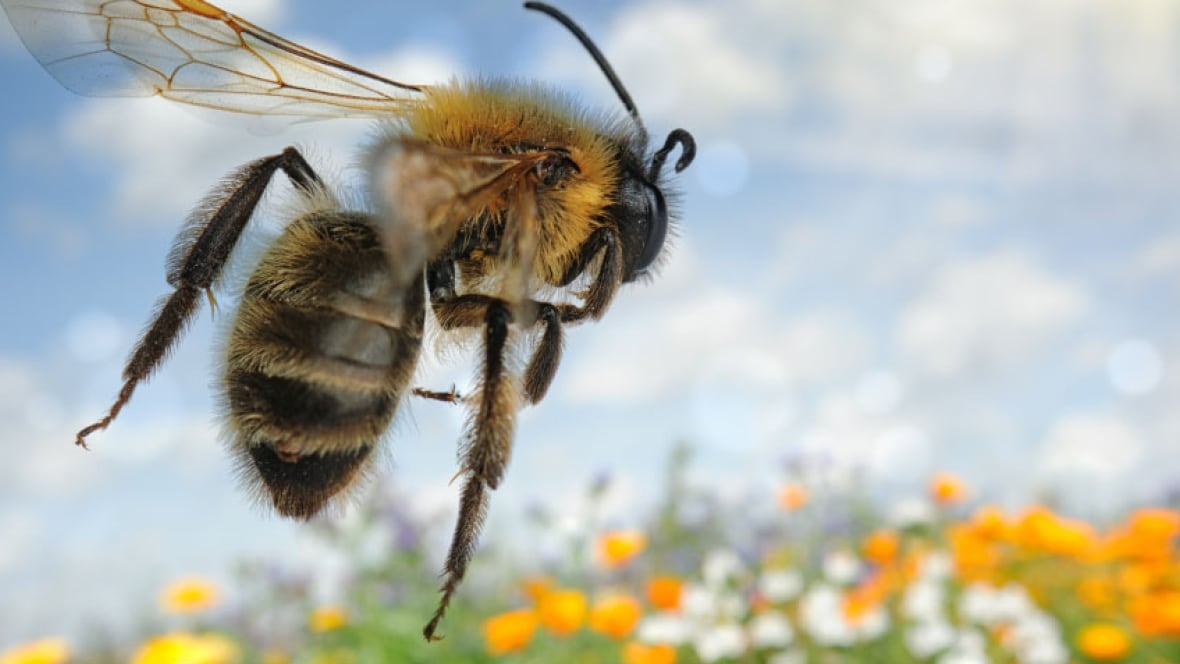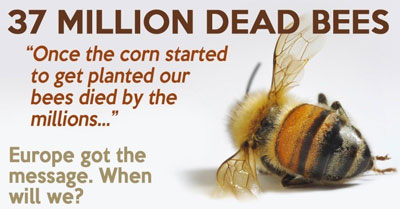
Trump OK’s Bee-killing Pesticides on 13.9 Million Acres
Ethan Strimling / Mayors Against Trump & MoveOn.org
(June 29, 2019) — Donald Trump’s EPA just approved the “emergency” use of bee-killing pesticides on 13.9 million acres of farmland. [1]
This after we just learned that nearly 40% of honeybee colonies were lost last winter–the greatest hive loss in 13 years. [2]
With Trump ignoring science and gutting protections for bees, it’s up to local governments to step up and give bees the protections they need. I led the effort to ban bee-killing pesticides in Portland, Maine, and I’m calling on other local leaders join me.
Federal law allows pesticides that would otherwise be banned to be used in “emergency” situations. Presumably, those emergencies should be rare events. But an analysis by the Center for Biological Diversity found that so-called “emergency exemptions” for bee-killing pesticides have become a routine way for corporate agribusiness to evade the law and pour otherwise banned chemicals on millions of acres. [3]
This latest “emergency” exemption includes Alabama, Arkansas, California, Georgia, Kansas, Louisiana, Missouri, Mississippi, Tennessee, Texas and Virginia. But in 10 of the 11 states, this same exemption has been granted for at least four consecutive years.
How can it be an “emergency” if it happens every single year?
Here’s what’s at stake: Bees and other insect pollinators are responsible for helping grow one in every three bites of food we eat. Without bees, we simply won’t have enough food to feed ourselves. That’s why I led the effort to ban bee-killing pesticides in my city, and now we need other cities to do the same.
Ethan Strimling is the Mayor of Portland (ME)

More Bad Buzz For Bees: Record Number Of Honeybee Colonies Died Last Winter
Susie Neilsen / National Public Radio
(June 19, 2019) — It’s a sweltering morning in Beltsville, Md., and I’m face-to-face with bee doom. Mark Dykes, a “Bee Squad coordinator” at the University of Maryland, shakes a Mason jar filled with buzzing honeybees that are coated with powdered sugar. The sugar loosens the grip of tiny Varroa mites, a parasite that plagues bees; as he sifts the powder into a bowl, they poke out like hairy pebbles in snow.
“Right now there [are] three mites per hundred [bees],” says Dennis vanEngelsdorp, associate professor of entomology at the University of Maryland and president of the Bee Informed Partnership, which studies bee survival rates. That’s a high rate of mites, vanEngelsdorp says: “If this were September and you were seeing that number, you’d expect the hive to die” during the lean months of winter.
Bee colony death continues to rise. According to the Bee Informed Partnership’s latest survey, released this week, U.S. beekeepers lost nearly 40% of their honeybee colonies last winter — the greatest reported winter hive loss since the partnership started its surveys 13 years ago. The total annual loss was slightly above average.
The survey included responses from nearly 4,700 beekeepers managing almost 320,000 hives, making up about 12% of total managed honey-producing colonies in the United States.
Bee decline has many causes, including decreasing crop diversity, poor beekeeping practices and loss of habitat. Pesticides weaken bees’ immune systems and can kill them. Varroa mites (full, ominous species name: Varroa destructor) latch onto honeybees and suck their “fat body” tissue, stunting and weakening them and potentially causing entire colonies to collapse.
“Beekeepers are trying their best to keep [mites] in check, but it’s really an arms race,” says Nathalie Steinhauer, science coordinator for the Bee Informed Partnership and co-author of the report (vanEngelsdorp is also an author). “That’s concerning, because we know arms races don’t usually end well.”
Steinhauer says Varroa mites are the “number one concern” around wintertime. They’ve become harder to control, she says, because some of the tools that beekeepers have been using — chemical strips that attract and kill mites, essential oils and organic acids — are losing their efficacy.
Pollinators are responsible for one of every three bites of food we take, according to the U.S. Agriculture Department. Most of these pollinators are domesticated honeybees. They have become essential for many flowering crops, including blueberries, almonds and cherries. Wild insects can’t be relied on to pollinate hundreds of acres of these crops, so fruit and nut producers call in commercial honeybee colonies instead.
Beekeeping has thus become an essential cog in the machine of American industrial farming. But it’s a tough industry. Commercial beekeepers are so migratory that it’s difficult to track how many live in each state, and all that moving around is expensive and stressful. Beekeepers have to monitor thousands of hives for sickness and pests.
These winter losses have made business even tougher, says vanEngelsdorp.
“We’re not worried about honeybees going extinct. What we’re worried about is commercial beekeepers going extinct,” he says. When hives die, beekeepers can split healthy hives to replace their numbers — but it’s costly to do so. “The question is, how long can they do that and stay economically viable?”
If the beekeeping industry shrinks, he says, crop production will suffer. “If we want to continue to have a food supply that has the variety that we want, we need a movable pollination supply, and those are honeybees,” he says. “If we don’t have commercial beekeepers managing those, then we won’t be able to meet that demand.”
Maryann Frazier, a retired senior extension associate for the College of Agricultural Sciences at Pennsylvania State University, who was not involved with the survey, says its results are limited by the fact that they rely on self-reported data from beekeepers. Beekeepers who’ve lost a lot of bees may be more likely to contribute to the survey, she says.
Still, she says the results are troubling, if unsurprising. Stressed, sick bees in close proximity are likely to die during the winter months. And bees face increasing levels of stress. Until all parties work together to address the sources of that stress, she says, steep winter die-offs will continue.
“I don’t expect to see a change in losses over time for this reason. There’s been no significant effort to correct what’s causing the decline,” she says.
Take pesticides, she says. “There’s a huge amount of data [and] research showing pesticides are a significant player in the decline of honeybees and other insect species. And yet there’s been so little done to make a change on that front,” she says. “The EPA has been incredibly ineffective.”
She says that pesticide industry leaders often try to shift blame for bee declines solely onto Varroa mites and viruses when in fact, she says, “there is so much evidence that pesticides are a major player in the decline of honeybees.”
“And these things are synergistic,” she adds. Pesticides can compromise immune systems, so when a mite or other pest hits “a bee compromised by pesticides, it’s a downward spiral.” Other sources of stress, like changing landscapes, have not been corrected.
Honeybees are a “sentinel species,” Frazier says, meaning that their losses may warn humans of the larger trend of insect decline worldwide, including the decline of other pollinators like beetles and wild bees. “The picture is well beyond honeybees,” she says. “The whole system is crashing.”
Susie Neilson is an intern on NPR’s Science Desk. Follow her on Twitter: @susieneilson.
Posted in accordance with Title 17, Section 107, US Code, for noncommercial, educational purposes